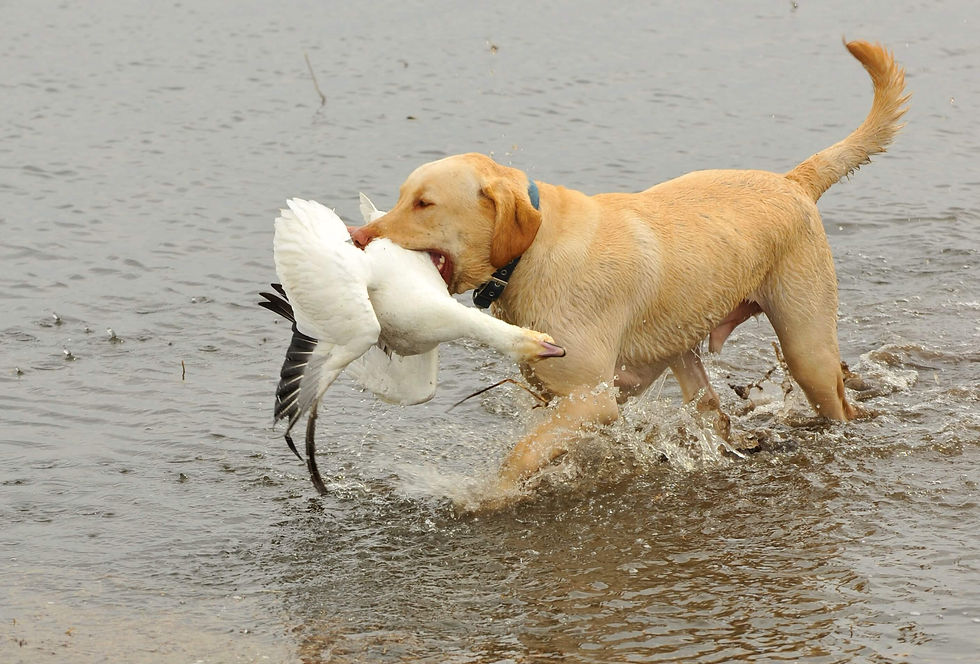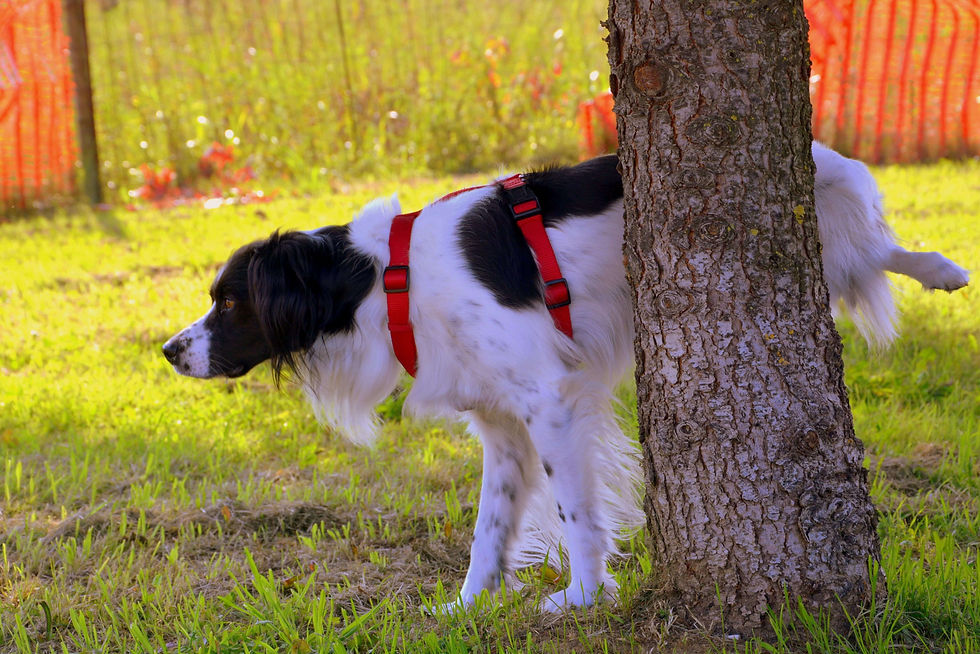Scholars Dig Up Dirt on Dogs
- Mal Cole

- Aug 18
- 6 min read
Unmindful Pet Ownership Can Be Hazardous to Nature

Dogs’ enthusiasm for the world around them can be contagious, and there’s no doubt that owning a dog can foster an appreciation for nature.
But Fido and Luna are still predators, and a new study shows that dog ownership can come at a cost to the environment, with impacts on bird populations, land, and waterways, and even through the massive pet food industry.
These impacts are serious enough to have been described as “insidious” in a new study, but dog owners can mitigate them with conscientious care of their pets.
‘Owned’ Dogs Studied
Owned dogs (ones that are considered domesticated pets and not wild, feral, or semi-feral) are the most popular pets in the world. There are an estimated 900 million pet dogs worldwide, including 13.5 million in the UK, over 62 million in Brazil, and almost 6.4 million in Australia, according to an analysis of the America Pet Products Association’s 2025 report.
However, the purpose of a comprehensive review published in Pacific Conservation Biology was not to detail the benefits of dog ownership but to examine the impact of pet dogs on the environment.
What the Australian researchers found was that pet dogs are “implicated in direct killing and disturbance of multiple species, particularly shore birds.” Also, dog feces and urine “can transfer zoonoses to wildlife and, when accumulated, can pollute waterways and impact plant growth.” Finally, pet dogs who have been treated for fleas or ticks can transfer those chemicals to waterways, endangering local wildlife.
“While the impact of cats, both feral and owned, on biodiversity has been relatively well-studied, by contrast, the comparative effect of owned dogs has been poorly acknowledged.”
“While the impact of cats, both feral and owned, on biodiversity has been relatively well-studied, by contrast, the comparative effect of owned dogs has been poorly acknowledged,” wrote study authors Curtin University Associate Professor Bill Bateman and colleague Lauren Gilson.
Shore Birds and Dogs
According to data collected from wildlife rehab centers referenced in the review, dogs are responsible for more attacks on wildlife than cats.
In an interview for this article, Bateman described this disparity as part of the motivation for his research.
“I was particularly interested in pet dogs because I think we give them a free pass,” he said. “I thought it would be interesting to dig down into the data and see if there’s any evidence that, specifically, pet dogs can have a negative effect on biodiversity.”
But it wasn’t just scientific curiosity that inspired Bateman—he also wanted to help members of his community who were noticing the negative effects of dogs and wanted scientific evidence to back up their concerns.
“I had spoken to people who would say things like, there are dogs chasing birds on beaches, and I want to talk to my local council and be able to say: Look, here is evidence that shows that dogs chasing birds on beaches has a negative effect.”
Bateman found that, indeed, pet dogs can have a marked effect on shore bird populations. The chasing instinct of dogs poses a particular threat to wildlife, and the study cites several examples of owned dogs causing devastating effects on endangered shore birds internationally, from little blue penguins in Tasmania to snowy plovers in California.
“We argue that the impact of owned dogs on the environment is far greater, more insidious, and more concerning than is generally recognized.”
In Australia, owned dogs “have been recorded as catching a higher proportion of native animal prey” than owned cats, and also take larger prey, the study said. “We argue that the impact of owned dogs on the environment is far greater, more insidious, and more concerning than is generally recognized,” Bateman and Gilson concluded.

Historically, the effects of dog attacks have been devastating to some sensitive bird populations. A 2024 study cited in Bateman’s review attributed a stunning 91% of reported penguin deaths in Tasmania from 1980 to 2020 to dog attacks. In 1987, a particularly brutal attack by wild dogs on brown kiwis in New Zealand reduced their population from an estimated 900 to just 400.
“One animal … can have an effect on a whole population of a rare breeding animal,” said Bateman.

Being subject to disturbances (including a dog’s chase instinct) can have a significant impact on migratory shore birds who travel hundreds of miles to breeding grounds they have used for generations.
After an arduous journey, the stress of being disturbed or chased by a dog may not kill the bird but could deter breeding behavior by making birds expend more energy to flying away. Although the effects of this kind of stress are difficult to measure, they can be severe.
“It’s actually having an effect on [the birds’] breeding potential, and therefore affects the survival of the species,” said Bateman.
Leash Laws
The idea that a beloved pet could cause destruction is sobering, but it also suggests that individual actions can make a big difference.
Leash laws can help protect endangered birds if the laws are obeyed, but the study found several examples of how dog owners skirt these laws. A 2014 study on free-ranging dogs and wildlife conservation cited in Bateman’s review showed that some wildlife perceived human-and-dog pairs as a greater threat than humans alone.
These direct effects of dogs on wildlife were part of what Bateman expected to find when he began his research. What surprised him was the unintended, cascading effects of dog ownership.
“It’s very easy to think, if a dog chases an animal, then that’s going to have a negative effect. But then, when we started digging into it, we started seeing things like just leaving a glandular scent mark had an effect on animals,” he said.
Diseases spread from dog waste are also a concern: Eighty percent of pathogens that infect domesticated pets could be spread to wildlife, including diseases and parasites found in dog feces, Bateman claims.

Other studies showed that the scent that dogs leave behind through glandular secretions, urine, and feces can cause wild animals to avoid the areas where dogs are commonly walked. Diseases spread from dog waste are also a concern. Per the study, eighty percent of pathogens that infect domesticated pets could be spread to wildlife, including diseases and parasites found in dog feces. Urine from dogs in urban areas was also shown to impact soil chemistry and contributed to excess nitrogen in waterways.
Common topical medications that dog owners use to protect their pets from fleas and ticks can wash off when a dog enters a waterway and harm the freshwater ecosystem. These medications were shown to be toxic to freshwater invertebrates even at low concentrations.
Moreover, fur from domestic animals is also frequently used by birds as a soft liner for nests. Pesticides can persist in treated fur for weeks after application, and this residue was shown to impact breeding populations of birds, causing more dead offspring and unhatched eggs.
The “Pawprint” of Pet Food
Bateman’s review included the environmental impact of dog food production.
“I never thought that I would be talking about things like the carbon footprint of the pet food industry, the effects of just the feces and urine that dogs produce—all this becomes very cumulative,” he said.
His study cited greenhouse gas emissions, agricultural land use, and freshwater use as elements of concern with dog food production.
As a 2020 study cited in the review noted, the environmental footprint (or “pawprint”) of the pet food industry was “equivalent to the footprint of almost twice the UK land area” (or about 24 Mha) and has the greenhouse gas emissions of “around the 60th-highest emitting country [in 2019].”
Raising Awareness Can Make a Difference
So, what’s a dog lover to do? Bateman recommends dog owners obey leash laws, use designated dog parks, always pick up dog waste, and find environmentally friendly pet food options.
Pet ownership carries many benefits from companionship to medical services, but dog populations far outnumber other predators, and some people may want to rethink owning a dog.
Per Bateman, one of the biggest issues is the sheer number of dogs.
“Ultimately, it’s about, do you really need a dog? And that’s not just about the environmental effect. That’s also about the welfare of the dog.”
“Ultimately, it’s about, do you really need a dog? And that’s not just about the environmental effect. That’s also about the welfare of the dog,” he says. He recommends that dog owners look after their dogs as best they can and consider owning only one dog.
Bateman himself has owned dogs in the past—and may again in the future, he says. He hopes that this study wouldn’t discourage a conscientious dog lover from owning a dog. Instead, he aims for this work to inform the public about a complex issue and empower advocates who want scientific evidence to back up the little-known negative effects of dog ownership.
“Please see this as a way of raising awareness, because it certainly raised our awareness,” said Bateman. Ultimately, it’s the responsibility of humans, not dogs, to make sure that biodiversity and the natural world remain a resource for everyone.
*Mal Cole is a freelance science and nature writer based in Massachusetts.








Comments